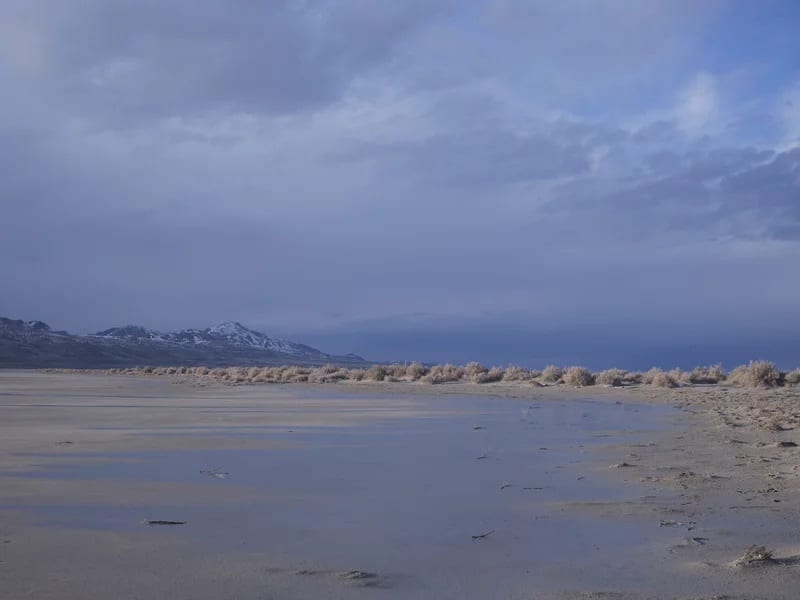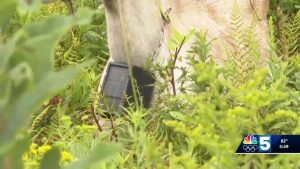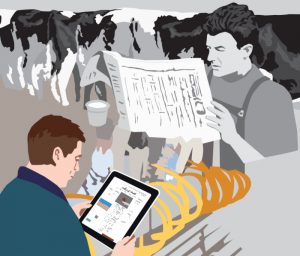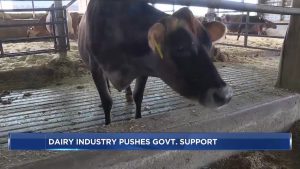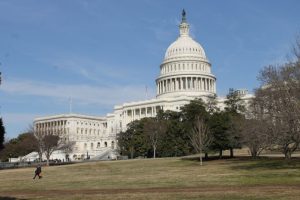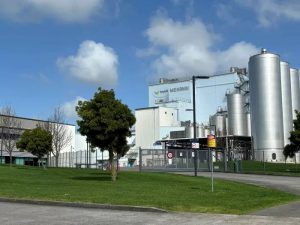
But on a recent afternoon, a brown cloud blanketed the valley, obscuring views of the downtown skyline. You could barely make out the Great Salt Lake off to the West.
Salt Lake City is notorious for having some of the dirtiest air in the country in the winter.
“This is dangerous air quality that we’re sitting in and this drying lake bed is making the situation worse,” Seed says.
Seed, who works for the green group Center for Biological Diversity, is talking about the recent rise in dust storms blowing naturally occurring toxins — such as arsenic and lead — off the drying lake bed and into neighborhoods like hers.
“This is a life defining crisis for us in northern Utah,” Seed says.

Deeda Seed with the Center for Biological Diversity says Utah leaders are shying away from making the tough political choices needed to save the lake.
Kirk Siegler/NPR
In a lawsuit filed last year against the state, Deed’s group and others went on to call the drying Great Salt Lake — the American West’s largest and one of the world’s few remaining giant saline lakes — a looming ecological collapse.
That suit came on the heels of a report by Brigham Young University scientists that set off alarm bells for many in the state saying the lake could dry up within five years if no action is taken. The lawsuit seeks to force state leaders to drastically cut how much water farmers use and let it flow into the lake. But as Spring planting time approaches, many farmers say fears about the lake drying up are being overblown.
Environmentalists want to stop alfalfa farming in the desert
The Great Salt Lake’s shrinking is already killing the brine shrimp that feed migratory birds. The dust storms are also increasingly threatening Utah’s snowpack and its snow-fed reservoirs, not to mention the lake effect snows themselves that help the state’s multi billion dollar ski industry.
Seed says Utah leaders just aren’t making the tough political choice to cut water to alfalfa farms and dairies north of the lake.

An empty boat harbor sits on the receding waters of the Great Salt Lake near Antelope Island in 2021.
Lindsay D’Addato
“We can’t afford to continue to do that with our water in the West,” she says. “Those farmers need to be compensated so they can retire from farming.”
This is a popular refrain right now from California to Utah where precious river water channeled through irrigation canals is used to grow thirsty feed crops, some for export, even as droughts in the West are getting worse with climate change.
Utah is the second driest state in the country yet it also has the highest water use per capita. But farmers say they’re being unfairly maligned in the fight over the imperiled lake.
80 miles north of the city, ringed by snowcapped mountains, is the fertile Cache Valley where the Subarus and ski racks so common in Salt Lake City give way to pickup trucks hauling farm equipment.
Farmer Clay Carter says alfalfa is actually one of the most efficient crops to grow because it can lay fallow for a year or more, then be brought back. Feed crops like it grown in this valley are vital to the West’s booming dairy industry.
“Farmers are maybe some of the best conservationists in the country and they seldom get the credit for it,” Carter says.

On a factory floor in Logan, Utah, farmer Clay Carter demonstrates his company’s new irrigation technology that he says helped cut his water use in half.
Kirk Siegler/NPR
Here in the Bear River basin, hundreds of millions of dollars is tied up in a 130 year old canal system that takes water out of tributaries upstream of the lake, and delivers it to farms.
Carter relies on this irrigation water to grow alfalfa and other feed crops on his family’s farm just north of the lake.
But today he’s on the factory floor of the engineering company he also owns. They build automated watering systems designed to more efficiently grow irrigated crops in the desert. He switches his on or off, or adjusts them based on what the weather is doing, all from his phone.
“I don’t even have to be on the property to do it,” Carter says.
And lately, he says he’s growing just as much alfalfa with half the water. In his mind, Utah doesn’t have to choose between farming and saving the Great Salt Lake. But he says getting everyone here to do what he did will take time and a lot of money.
“You’re talking twenty years of drought that have created this problem,” Carter says. “It may take us twenty years of finding and deploying solutions to get to a viable and working solution.”
Farmers say they want to save the Great Salt Lake too
Carter doesn’t see the same five alarm fire that scientists and environmentalists are warning about down in the city. But farmers in the Cache Valley insist they don’t want to see the lake dry up either.
Todd Pearce and his father-in-law grow alfalfa to feed their dairy cows that produce cheese for the company Organic Valley. Pearce worries that if more water doesn’t start flowing into the lake soon and the wildlife continue to decline, the federal government might intervene with an Endangered Species Act listing.

Todd Pearce’s family grows alfalfa to feed their dairy cows that produce cheese for the company, Organic Valley.
Kirk Siegler/NPR
“If we destroy their habitat by not giving the water that the Great Salt Lake needs, we’re going to get federal regulations that make us save that water,” he says.
To get ahead of that, Utah lawmakers in the last year put hundreds of millions of dollars toward conservation, including grants for farmers to switch to those new efficient irrigation systems or paying them to sometimes let their water flow downstream into the lake.
But so far, it’s widely thought that barely a trickle of irrigation water has actually gotten there.
“It’s not happening very much because everyone sees their water as use or lose,” Pearce says. “So, if I’m not using it, the person down the road or down the ditch is gonna use it.”
Governor says predictions the lake will dry up in five years are “laughable”
This might explain some of the anger and frustration being directed at farmers right now in the fight over the lake. Utah Governor Spencer Cox, who’s pledged it won’t dry up under his watch, is urging patience.
“I’m far less worried about the lake now than I have been at any time in the past three or four years because we have invested a billion dollars, we have a plan,” Cox told NPR in an interview. “We’ve changed more than a century’s worth of law in the state.”

Utah Republican Governor Spencer Cox says the “five alarm fire” over the Great Salt Lake has ended because state leaders have a comprehensive plan to address the crisis.
Kirk Siegler/NPR
Cox, himself an alfalfa farmer, says just buying out farms or fallowing fields could destroy Utah’s rural economy.
His plan to save the lake, which now includes an appointed Great Salt Lake commissioner, is mapped out over the next couple decades. This, even though some Utah scientists have warned the lake could dry up within five years if no action is taken.
“That prediction is laughable. It’s a joke and everybody knows it’s a joke. They were never serious about that,” Cox says. “That’s the ‘doomerism’ that is terrible for people.”
Green groups say the state is putting the economy ahead of public health
Still, scientists say there’s solid evidence the lake is in trouble, putting the ecosystem and public health in jeopardy.
Back in the Salt Lake Valley, where about 80% of Utah’s 3.3 million people live, Physician Brian Moench says if the toxic dust storms get much worse combined with the already poor air, people will start moving away.

People play tennis amongst the smog in the Salt Lake valley in 2021.
Lindsay D’Addato
And there won’t be any market left for the farmers to sell to.
“We’re very distressed that there isn’t a continued urgency to address this problem,” Moench says.
Moench leads Utah Physicians for a Healthy Environment, which joined the lawsuit against the state. He says he’s recently been having tough conversations with his own kids who want to move home to Utah.
“We would love to have our family be reunited. But I have to honestly say that I’m not sure that that’s a good idea given our air pollution,” he says. “Now how tragic is that?”
It’s a tragedy that in Moench’s view, is preventable. A hearing for the lawsuit has yet to be set. But the state recently filed a motion asking the court to dismiss it.
